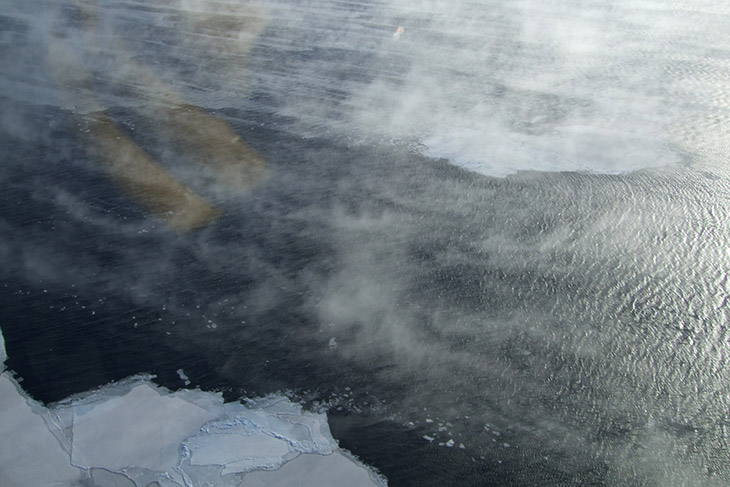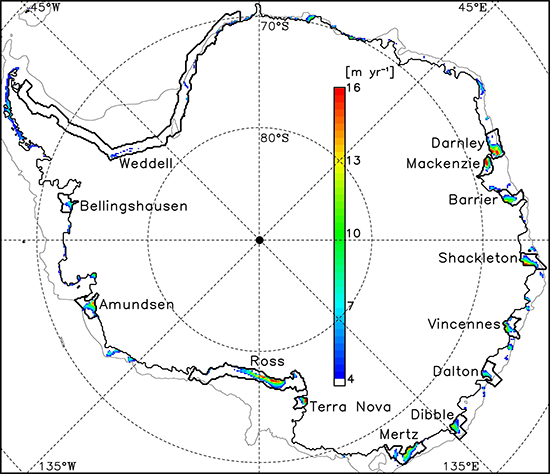National Institute of Polar Research
[Research Highlight] Changes in Antarctic sea ice production due to surrounding ice conditions - Impact of the changes to the ice sheet on global ocean circulation
Released on May 13, 2016 (in Japanese)
Posted on June 30, 2016
National Institute of Polar Research
Antarctic sea ice production spanning more than 20 years has been understood through the analysis of satellite observations using specially developed techniques. The results of this analysis revealed that changes to the sea ice production in the Southern Ocean were caused mainly because of surrounding ice shelf and fast ice conditions, rather than by wind, temperature, or other factors.
In Antarctic coastal polynyas (polynya: a location in the ocean wherein a section of the sea ice opens up and exposes the ocean surface; Figure 1), the sea ice is produced when ocean water comes in contact with cold air.
The high sea ice production of Antarctic coastal polynyas is attributable to the formation of Antarctic Bottom Water (AABW), which is a driving force for global ocean circulation. Sea ice production varies year to year as well as seasonally; however, there are various explanations for the factors that increase or decrease this production, such as wind, temperature, and surrounding ice conditions, which have not been understood till date.
Dr Takeshi Tamura at National Institute of Polar Research, Japan, and his research team developed an algorithm for calculating sea ice production from satellite remote sensing data, and were the first in the world to succeed in mapping sea ice production in both the Arctic and Antarctic regions. In this study, this algorithm was used to analyze long-term (1992–2013) sea ice production in the 13 main Antarctic coastal polynyas, and the average values (Figure 2) and annual variability of sea ice production were calculated. Furthermore, the sea ice production volume was verified by bio-logging the data of Elephant seals (Mirounga Lenonina).
These results show that sea ice production decreased in years when major events such as an ice shelf collapse or the collapse of a glacier occurred. The results also indicate that sea ice production increases in polynyas wherein off-shore first-year ice has decreased. Dr Tamura states that “With Antarctic coastal polynyas, changes to surrounding ice such as ice shelves and glaciers, fast ice, and off-shore first-year ice play a more important role in sea ice production than wind and temperature, such as what the Southern Annular Mode (SAM) does.”
Furthermore, he comments that, “Antarctic coastal polynyas—in which there is large annual variability in sea ice production—are areas of the sea in which ice shelf fusion has accelerated in recent years. There is a possibility that these will have a large impact on changes to Antarctic Bottom Water (AABW) in the future, and therefore monitoring is essential.”

Figure1: Conditions of sea ice production in Antarctic coastal polynyas. The sea water freezes, resulting in the formation of thin ice. Steam may also rise because of the difference between the air and sea water temperatures (photograph taken at Dalton polynya, September 13, 2007). Credit: Takeshi Tamura

Figure2: Mapping of Antarctic sea ice production (annual cumulative production volume: average values between 1992 and 2013). Sea ice production converted into thickness (m). Credit: Tamura T. et al., J. Geophys. Res. Oceans, 2016
Published Paper
Takeshi Tamura (NIPR/SOKENDAI/University of Tasmania), Kay I. Ohshima (Hokkaido University), Alexander D. Fraser (University of Tasmania/Hokkaido University), and Guy D. Williams (University of Tasmania)
Sea ice production variability in Antarctic coastal polynyas, J. Geophys. Res. Oceans, 121 (2016), 2967–2979
URL: http://onlinelibrary.wiley.com/doi/10.1002/2015JC011537/full
DOI: 10.1002/2015JC011537
Acknowledgement
This study was supported by Grant-in-Aid for Scientific Research No. 26740007 from the Japan Society for the Promotion of Science and by Canon Foundation.
Contact
Public Relations Section, National Institute of Polar Research
E-mail: kofositu@nipr.ac.jp








